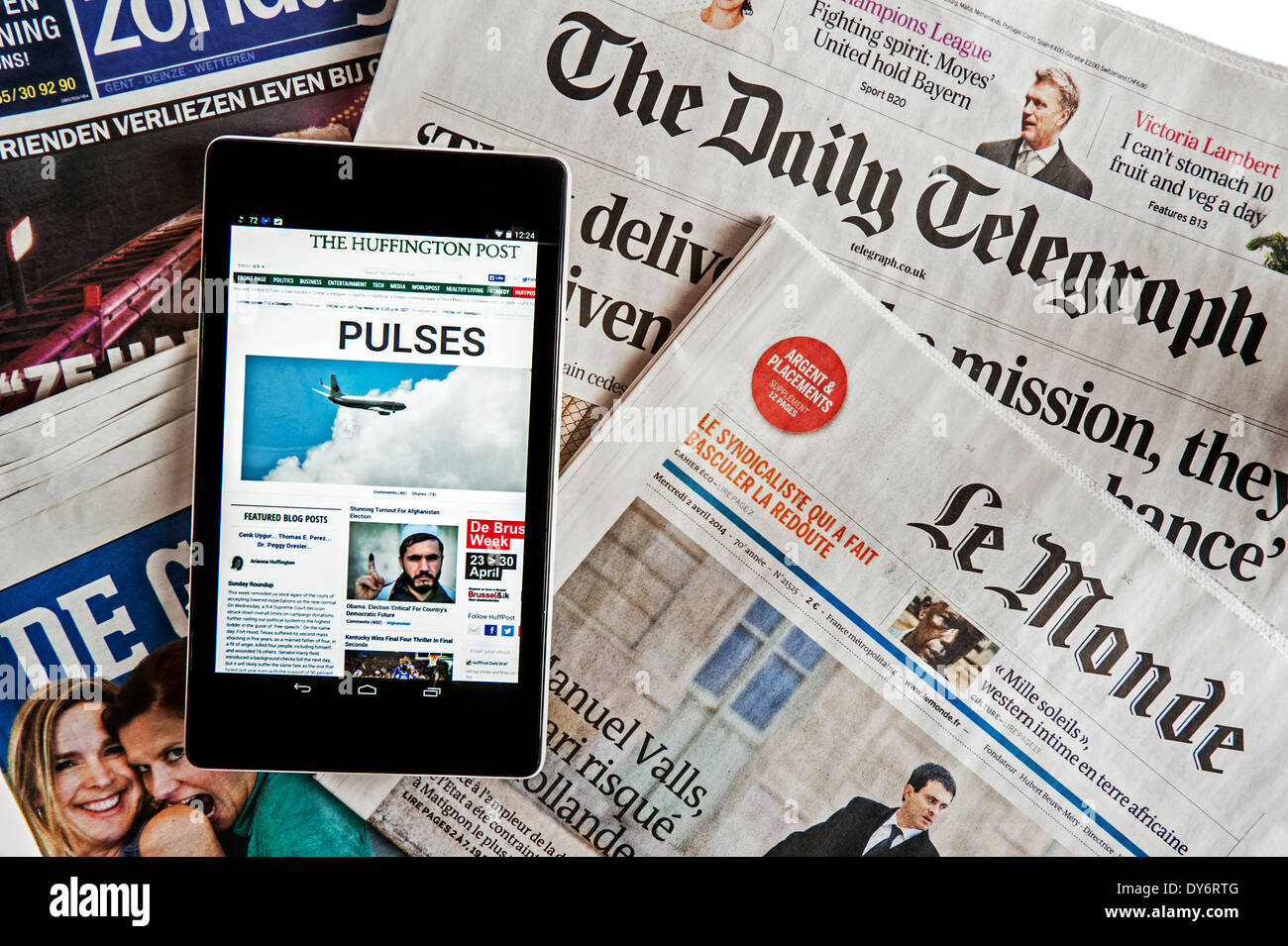Inside Look at How stnews.live Publishes News
Wiki Article
The Effect of Social Media on the Means We Eat News Online
Social media has actually basically transformed news intake. It gives prompt accessibility to details, often overshadowing standard media electrical outlets. This quick dissemination comes with difficulties. Users encounter the risk of running into misinformation and coming to be entraped in echo chambers. The formulas driving personalized web content can obscure diverse point of views. As these dynamics progress, recognizing their implications ends up being essential for educated interaction in public discourse. What methods might aid browse this complex landscape?The Advancement of News Usage in the Digital Age
As modern technology progressed, the way individuals taken in news changed considerably in the digital age (stnews.live). Standard newspapers and transmitted media began to decrease as the web arised as a primary source of information. On the internet platforms offered instantaneous accessibility to newspaper article, videos, and podcasts, allowing customers to stay notified any time. The ease of smart phones additionally increased this change, allowing customers to get updates on the moveAdditionally, the surge of news aggregators and internet sites promoted the usage of varied viewpoints, equipping customers to customize their news intake based on personal interests. This advancement additionally motivated wire service to adjust their strategies, concentrating on electronic content and interesting visitors through multimedia formats. Because of this, the typical obstacles of time and room in news distribution decreased, bring about a more prompt and individualized news experience for target markets worldwide.
The Function of Social Media Site Operatings Systems in News Distribution
Social network platforms have actually changed news circulation by providing instant access to info. Their algorithm-driven material curation usually prioritizes involvement over accuracy, resulting in considerable integrity difficulties (stnews.live). As customers navigate this landscape, the implications for news consumption and public discourse come to be significantly complexInstant News Access
Although typical news electrical outlets have actually long been the primary source of info, the increase of social networks systems has actually considerably transformed how news is accessed and taken in. Immediate news gain access to has ended up being a characteristic of the electronic age, making it possible for users to receive updates in genuine time. Platforms such as Twitter, Facebook, and Instagram permit news to spread out rapidly, often surpassing standard media in rate and reach. Users can share stories, discuss events, and engage with journalists, creating a dynamic communication in between the audience and news material. This immediacy cultivates a culture of urgency, prompting users to look for info swiftly. As a result, the assumption for prompt news has actually improved journalistic practices, engaging wire service to adapt their techniques to meet the needs of a hectic digital environment.Algorithm-Driven Content
While customers proactively engage with content on social networks, the formulas that govern these systems play a crucial duty in determining which news stories gain visibility. These formulas examine individual actions, preferences, and involvement metrics to curate individualized news feeds. As a result, certain tales might be magnified while others remain rare, typically prioritizing sensational or trending subjects over substantive reporting. This discerning direct exposure shapes users' understandings of current events and affects public discourse. The reliance on algorithm-driven content can produce echo chambers, where customers are generally exposed to viewpoints that line up with their own ideas. As a result, the characteristics of news distribution on social media sites platforms substantially impact just how people consume and translate details in the digital age.
Credibility Obstacles
As customers progressively turn to social media sites for news, the integrity of info come across on these platforms becomes a pressing issue. The decentralized nature of social networks enables anybody to publish content, usually blurring the lines between dependable journalism and misinformation. Formulas focus on engagement over accuracy, causing the prevalent circulation of sensational or misleading tales. This atmosphere presents significant difficulties for individuals attempting to recognize reliable resources. Social network platforms, while striving to combat false information with fact-checking and content small amounts, run the gauntlet for inconsistencies and biases in their approaches. Ultimately, the obligation exists with users to critically examine the news they consume, as the rapid spread of info commonly exceeds confirmation initiatives by systems.The Increase of Citizen Journalism and User-Generated Material
The rise of person journalism has actually encouraged everyday individuals to share news and point of views, often supplying insights that conventional media might forget. This shift additionally presents considerable obstacles, especially the spread of false information that can emerge from unverified content. As user-generated material comes to be more common, the balance in between authentic voices and precision in coverage stays an important concern.Encouraging Everyday Voices

Obstacles of Misinformation
While the surge of person journalism has opened opportunities for varied voices in the media landscape, it has additionally introduced significant difficulties associated with misinformation. The ease of sharing info through social media systems enables individuals to share news promptly, however this fast spread typically comes at the cost of accuracy. User-generated content frequently does not have the rigorous fact-checking and content oversight that conventional journalism gives. As a result, sensationalized or false narratives can get traction, misleading target markets and forming public assumption (stnews.live). The blending of opinion and truth within check this social media complicates the difference in between qualified information and false information. As an outcome, customers need to browse a progressively complex media environment, needing important assuming abilities to recognize reputable news resources amidst the noise
Misinformation and Its Ramifications for Public Discussion
As social media platforms progressively dominate the landscape of info dissemination, the proliferation of false information positions substantial challenges for public discussion. Misinformation, usually created to misguide or prompt emotional responses, can distort perceptions of truth and threaten rely on qualified sources. This sensation leads to polarized perspectives, as individuals are attracted in the direction of resemble chambers that reinforce their beliefs, even more lodging departments within culture.The implications for public discourse are extensive. When people rely upon incorrect information, purposeful discussion diminishes, and the democratic procedure endures. False information can incite anxiety and confusion, influencing public health, safety and security, and political stability. As an outcome, cultivating media literacy becomes vital, encouraging individuals to seriously review information and discern truth from fiction. Addressing the challenges positioned by misinformation is important for protecting the honesty of public discussion and making sure an educated populace qualified of taking part in useful conversations.
The Impact of Algorithms on News Visibility
Offered the main role of formulas in figuring out content presence, their influence on news consumption is profound. These formulas, used by social networks platforms, focus on particular sorts of material based on user involvement and preferences. Therefore, newspaper article that align with prominent trends or target market rate of interests are more probable to be shown prominently, while less thrilling stories may be overlooked. This produces a setting where users are subjected primarily to details that strengthens their perspectives, potentially resulting in resemble chambers.Additionally, the consistent evolution of algorithms suggests that wire service should adapt their strategies to align with redirected here these transforming parameters, typically prioritizing clickbait or mentally charged headings. As a result, the honesty of news coverage can be endangered, as essential stories may not receive the exposure they are entitled to. The mathematical shaping of news presence consequently plays a vital duty in affecting public understanding and understanding of current events.
The Shift Towards Aesthetic Narration in News Media
Significantly, news media is accepting visual narration as an effective tool to involve target markets. This approach leverages images, videos, infographics, and interactive elements to convey info better than typical text-based layouts. As attention extends reduce, visuals offer a fast, impactful way to interact complex tales and get visitors' passion.Platforms like Instagram and TikTok have further accelerated this trend, engaging wire service to adapt their content methods to fit these visually-driven atmospheres. By integrating engaging visuals, news electrical outlets can improve psychological links and foster higher understanding of topical concerns.
Moreover, aesthetic narration enables for even more diverse narratives, showcasing several point of views with dynamic discussions. As audiences progressively consume news via mobile phones, the change towards visuals not only provides to user choices but likewise helps to damage down barriers to info gain access to. Ultimately, this development reflects a wider change in exactly how news is created and consumed in the his response digital age.
Future Trends: Browsing the Changing Landscape of News Consumption
While the electronic landscape proceeds to develop, news intake is positioned for considerable change driven by emerging technologies and transforming target market behaviors. As expert system and device understanding advance, customized news feeds will come to be much more prevalent, enabling users to receive material tailored to their rate of interests. This customization might cause better involvement yet additionally elevate issues about echo chambers and false information.Moreover, the increase of voice-activated devices and wise audio speakers will influence exactly how news is delivered, moving the emphasis from aesthetic to acoustic styles. This trend might motivate wire service to take on even more succinct and interesting audio content.

Often Asked Inquiries
How Do Social Media Site Interactions Affect News Trustworthiness?
Social network communications can greatly influence perceptions of news integrity. Engagement metrics, such as likes and shares, commonly form audience count on, with preferred articles getting regarded legitimacy, regardless of the precision or integrity of the details provided.What Duty Do Influencers Play in Shaping News Narratives?
Influencers considerably form news stories by leveraging their platforms to magnify certain stories, typically customizing web content to their audience. This can lead to biased perspectives, impacting public perception and focusing on sensationalism over factual reporting.Just How Can Users Identify Reliable News Resources on Social Network?
Users can recognize reputable news sources on social networks by examining the resource's trustworthiness, validating truths through numerous outlets, assessing the professionalism and reliability of the web content, and recognizing prospective prejudices in reporting to guarantee precise details.What Impact Does Social Network Carry Traditional Journalism Jobs?
Social network substantially affects traditional journalism tasks by modifying revenue models, decreasing demand for print media, and promoting competitors from person reporters. Many professionals deal with task insecurity and should adapt to quickly altering media landscapes.Exactly How Do Different Demographics Consume News on Social Media Site?
Various demographics show diverse choices for news intake on social networks. More youthful audiences favor systems like TikTok and Instagram for quick updates, while older individuals have a tendency to like Twitter and facebook for a lot more thorough conversations and short articles.Report this wiki page